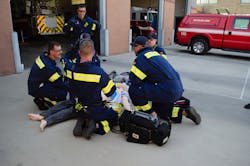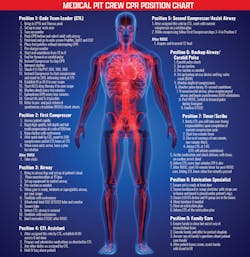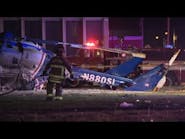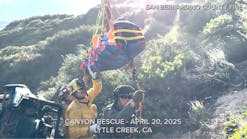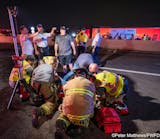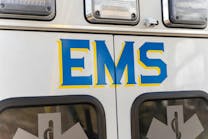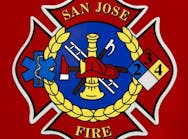In 2021, Mike Rossi, a 29-year veteran firefighter at the Spokane, WA, Fire Department (SFD), was in Missoula, MT, visiting family at Christmastime. Shortly after midnight on Dec. 27, his heart suddenly stopped.
His family quickly called 9-1-1, reporting that a healthy 52-year-old male was in cardiac arrest. The Missoula Fire Department (MFD) was dispatched to a cardiopulmonary resuscitation (CPR) incident. Rossi’s family started CPR while they awaited the arrival of first responders.
When responders arrived, Rossi was on the floor in cardiac arrest. The patient’s son, who was a newly certified EMT with the SFD, was doing high-quality chest compressions on his father.
MPD officers arrived first. They applied fast patches from an automated external defibrillator (AED) and delivered the first defibrillation. Paramedics on MFD Engine 131 entered the home seconds later and followed the MPD officers’ defibrillation with two additional shocks to the patient.
Perhaps not so unlike Roger Penske’s direction over Team Penske members on race day, the lead paramedic assigned specific roles, having slid into the so-called Pit Crew CPR protocol. As additional resources arrived, they were assigned roles, too, within the Pit Crew CPR framework. What followed was continuous, coordinated high-quality CPR that saved Rossi.
Rossi likely is alive because of the quick and decisive action that his son and other family members took that night (early 9-1-1 notification, immediate bystander CPR). However, equally important is the SFD’s willingness to share its knowledge, expertise and time to mentor the MFD in Pit Crew CPR.Sharing knowledge
Pit Crew CPR was developed some 10 years ago by the U.K.’s National Health Service. It’s based on the concept of Formula 1 pit crews’ diligence in duties and efficiency.
In essence, as each person on the CPR “pit crew” enters the scene, a very specific role is assigned. This approach delivers an organized and rapid response to cardiac arrest incidents. If performed correctly, the opportunity to save lives is improved compared with standard practice. Departments around the world have been implementing the new protocol. That includes in the Pacific Northwest, including in Missoula in March 2015.
Having learned of the increasing success with cardiac arrest survival rates that the Spokane, WA, Fire Department (SFD) and the Spokane Valley, WA, Fire Department (SVFD) were garnering,
Ron Brunell, who was the MFD EMS coordinator at the time, communicated with SVFD Capt. Sean Barrett. This resulted in the opportunity for Brunell to learn from and train with the SFD and the SVFD, both of which employ Pit Crew CPR.
Brunell returned to Missoula eager to share the information with the operations crews. One of his first stops was with MFD Medical Director Dr. Michael Kremkau, for his input and guidance. Brunell’s next stop was with the MFD’s administration, to secure a minimal budget increase of $4,000. He received it, and the green flag was waved for the start of the implementation of Pit Crew CPR for the customers of the MFD.
Author’s Note: Barrett and fellow SVFD captain Dan Ward became aware of the new CPR protocol in 2010. They reached out to Dana Yost at the Redmond, WA, Fire Department (RFD), which implemented Pit Crew CPR three years earlier. The greater Spokane Valley operated under the Pit Crew CPR protocol for five years before Brunell reached out. The willingness of the SFD and SVFD and the RFD before them to offer up their time and expertise to improve a system that isn’t their own speaks volumes of the integrity of those departments’ medical providers and administration. Their desire to selflessly share for the benefit of the customer is the reason that those people entered the fire service. Such networking with other departments is crucial to continued development and constant improvement and to provide the greatest benefit to customers. The departments that proactively made these changes and tracked patient outcomes all have noticed one consistent trend: improved survivability and patient outcomes.
Pit Crew lineup
The entire MFD was trained using the new CPR techniques. The focus was on full-depth compressions with appropriate rate and recoil. Via the budget enhancement, manikins that provide real-time feedback regarding the quality of the work by the individual who is performing compressions, or the compressor, were purchased.
In Missoula, CPR incident response consists of two ALS engines, one battalion chief, one ALS ambulance and any nearby available MPD units. (On the incident that involved Rossi, 11 personnel responded: the MFD responded with seven personnel, Missoula Emergency Services with two personnel and the MPD with two officers.)
The first-arriving engine with three personnel fills the following positions. The lead paramedic is the Code Team Leader (CTL). The CTL brings the cardiac monitor/defibrillator and the ALS medical bag into the scene. The CTL is responsible for setting up the area where the code team operates; starting the metronome for consistent CPR rate; immediately placing fast patches on the patient; precharging the monitor; giving a verbal count down from 15–0 to stop CPR; feeling for a carotid or femoral pulse; interpreting the rhythm and defibrillating per protocol; and instructing the compressor to resume CPR.
Following the initial actions, the CTL establishes either an IV or IO, starts ACLS drug therapy, corrects Hs and Ts, if possible, and manages the code team.
The second position is the first compressor. This individual goes directly into the scene with no gear and starts CPR.
The third position is assigned airway. This provider brings the airway bag into the scene. Initially, the patient is placed on a nonrebreather at 15 liters per minute. The patient’s airway is secured and maintained within the provider’s scope of practice.
The three personnel of the second-arriving engine typically are assigned as follows.
The second-arriving paramedic becomes the CTL assistant (fourth position). That individual gains IV/IO access if it already wasn’t established, prepares and administers medications as directed by the CTL and carries out any other duties as assigned by the CTL.
The fifth position is the secondary compressor and the airway assistant. The two compressors rotate, doing CPR every two minutes. This minimizes CPR interruptions in coordination with the two-minute rhythm checks.
The sixth position is in charge of the secondary airway and carotid pulse. This individual checks pulses during rhythm check on either the femoral or carotid artery; sets up the suction unit; sets up all of the backup airway devices and bag-valve mask; monitors depth of the compressions; and confirms end-tidal carbon dioxide (ETCO2) readings.
The first-arriving MFD battalion chief becomes the seventh position. This individual notifies the CTL that he/she is taking over timing/recording; starts the two-minute timer; gives oral warning to the CTL of one minute and 45 seconds of CPR; records medications and defibrillations; and informs the CTL of how much time passed since a medication was given.
The first-arriving ambulance crew generally consists of one paramedic and one EMT. The paramedic can fill in as the CTL or CTL assistant. The EMT can fill in as the second compressor or as the eighth position, the extrication specialist.
Law enforcement usually fills the ninth position, which is family care. This ensures that the patient’s family is close but out of the way of the resuscitation team. The position also consoles family, offers to contact a chaplain, answers questions that the family might have and assists the family with travel to the ED/ER. In Missoula, the newly developed Mobile Support Team, including an EMT and licensed therapist, might respond to the scene to provide the family with any needed resources and services in support of the family.
Save lives
Today, the MFD collects all cardiac arrest data from incidents in its service area. The data are used to provide statistical analysis and direction for improvement. MFD crews are given feedback from information that’s recorded and transmitted during CPR incidents, which allows them to further refine their skills.
The knowledge that the MFD has gained was shared with local cooperators in the Missoula Valley to guide the quality of care. It took more than a year to get providers up to the desired standard goals. That’s OK. In 2015, when the SFD invited Brunell to come to learn its way of doing CPR, it did it knowing that the MFD—and all departments—have a common goal: save lives. Little did the SFD know that sharing its knowledge would have such a personal impact on Spokane and the fire departments of the Spokane Valley, when Mike Rossi’s life was saved.
Successful Cardiac Arrest Outcomes
Research indicates that the best chance of survival for a patient who suffer a cardiac arrest out of the hospital, includes the following:
• Witnessed arrest with early and effective bystander CPR
• Immediate 9-1-1 notification
• Early defibrillation
• High-quality, minimally interrupted CPR protocols, with first responders working as a coordinated team
• Upon return of spontaneous circulation (ROSC), early notification and immediate transport to cardiac catheterization lab
Philip Keating
Philip Keating has been with the Missoula, MT, Fire Department for 22 years. He recently was promoted to assistant chief.
Chris Kovatch
Chris Kovatch is a 15-year veteran of the Missoula Fire Department. He has a passion for prehospital medicine.
